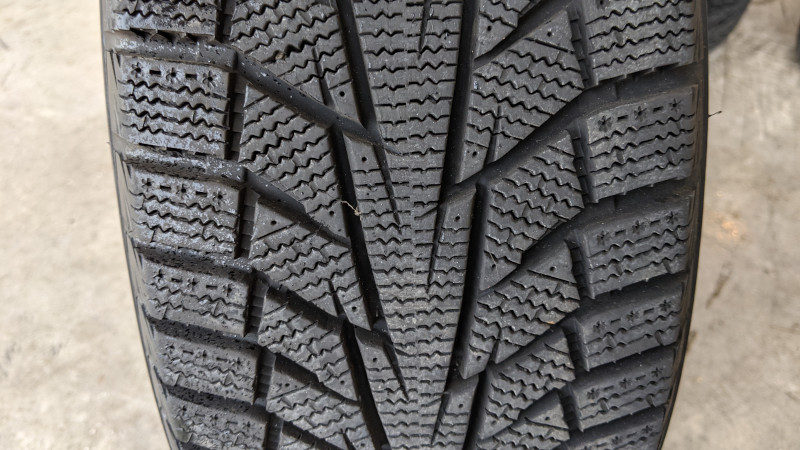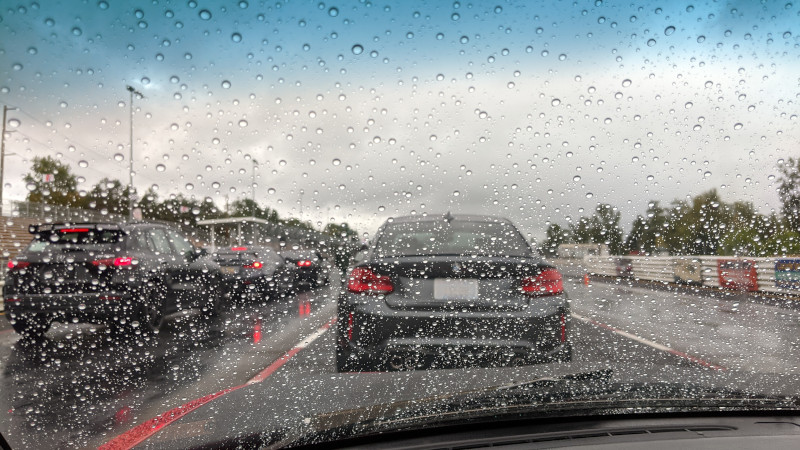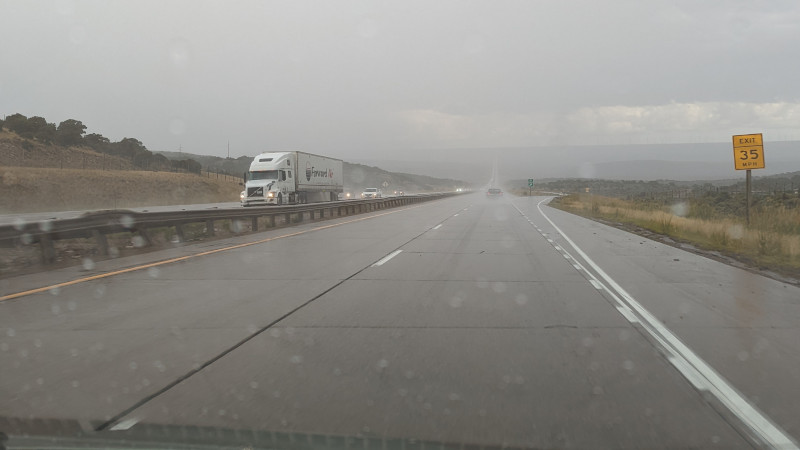Hydroplaning (also called “aquaplaning”) is a condition where the tires can’t displace water on the road fast enough. When excess water builds up under the tire, the tire lifts off of the road’s surface, compromising your ability to steer the vehicle.
As the seasons change and the weather gets worse, the odds of hydroplaning on a wet road increase. Although hydroplaning is very dangerous, there are some pretty simple ways to avoid this phenomenon. Here are some things to keep in mind before your next wet weather excursion.
What Causes Hydroplaning?
Road tires are built to displace large amounts of water. This is thanks to the tread and siping on the tires. Tire tread gives water a passage through part of the tire’s contact patch, while the main surface of the tire stays in contact with the road.
Sponsored Links
If the depth of water on the road surface exceeds the tire’s ability to displace the water, the tire will actually lift off of the road’s surface. The tire will then ride on top of a layer of water, rather than rolling across the road surface as it is designed to. A floating tire loses its ability to steer, just like a locked tire would for cars without an anti-lock braking system (ABS).
How to Avoid Hydroplaning
The best way to stay safe in the rain is to avoid hydroplaning altogether. Here are a few things you can do to minimize your chances of hydroplaning at all.
1) Slow Down
The best way to avoid hydroplaning is to slow down. Hydroplaning occurs at higher speeds, typically above 50 mph (80 kph). You are much more likely to hydroplane on a freeway than on a slower road in town.
2) Avoid Standing Water

Large pools of standing water can be dangerous because it can be hard to judge their depth. If you can’t make out the texture of the road through the water, you’re looking at standing water.
Sponsored Links
Standing water on the road will look more like a puddle than damp asphalt. Unless your tires are bald, you won’t hydroplane on just a damp road.
Look for spots in the road that are shinier than the rest. As it rains harder, you may notice water start to pool in the ruts, especially in areas where studded tires are frequently used. Studded tires can quickly damage a road’s surface when used on bare pavement.
Try to drive outside of these ruts as much as possible. You may need to shift your lane positioning slightly to the left or right to stay out of the ruts, but you’ll maintain much more grip this way. Avoid driving over painted sections of roadway like the fog lines when possible. Paint on the road can be very slippery.
Sponsored Links
How to Approach Standing Water
If you’re forced to approach a section of standing water, try to hit it as straight on as possible. If you hydroplane while going straight, your vehicle will likely want to continue in the path of intended travel. Aside from the loud “whoosh” sound as you splash through water and the gentle pull at the wheels, you may hardly notice you’ve just hydroplaned.
If you notice standing water in the curves, the best approach is almost always to slow down. You’ll probably want to slow down to the point where you won’t hydroplane at all. Hydroplaning in a corner can be very dangerous, as it is much easier to lose control over the vehicle or run into another lane.
3) Buy Tires with Good Tread Depth

Nothing combats hydroplaning quite like having the right tires. If you have fresh tires that are made to displace high volumes of water, you are far less likely to hydroplane.
Sponsored Links
Bald tires will hydroplane very easily. It’s important to pay attention to your local laws on tread depth. If the law says to replace your tires at 2/32 inch, start looking for new tires when you hit 4/32″. Colorado has a Traction Law that requires a minimum tread depth of 3/16″, which is equivalent to 6/32″.
What to Do if You’re Hydroplaning
Hydroplaning can be scary if it catches you by surprise, even for seasoned drivers. Here are some practical driving tips you can implement on your next rainy adventure.
1) Use Smooth Inputs
Don’t slam on the brakes or crank the wheel quickly to one side. If you feel the need to brake, brake smoothly and gently. The standing water you hit while hydroplaning will naturally slow you down a bit. In many cases, braking while hydroplaning is not necessary at all.
Sponsored Links
Abrupt inputs are much more likely to upset the vehicle when it is already in an unsettled state. This may lead to an overcorrection and cause a crash.
2) Keep the Wheel Pointed Where You Want to Go

Depending on how you hit the standing water, the rear end of your car might start to slide. Make sure you keep the front wheels pointed in the direction you want to go. When you regain traction, this will ensure you continue on your intended path.
This concept is especially important if you only hit standing water on one side of the car. For instance, if the left two tires hydroplane and the right two tires maintain grip, the car will want to pull gently (but quickly) to the left. Keep the steering wheel pointed down the road and you will maintain your current path; you probably still have enough grip on the right side to effectively steer the car.
Correcting a hydroplane in a turn is situational and will require a bit of practice driving your car at the limit. If you’re in a turn when you hydroplane and your car starts to push toward the outside of the turn, it may help to straighten out the wheel just a little bit. This could help prevent snap oversteer if your tires quickly regain traction.
Sponsored Links
If you feel the need to countersteer while hydroplaning, be ready for a violent swing in the opposite direction when your tires regain traction. Be very careful that you don’t overcorrect and lose control in this scenario.
3) Don’t Panic
Try not to panic if you start to hydroplane. Most hydroplaning events are recoverable if you wait for the tires to touch back down on the pavement. Let the car tell you what it needs. When in doubt, keep the wheel pointed where you want to go.
Many modern stability control systems are very good at helping you stay on the road when the car knows the driver’s intent. One important way the computers determine the intended direction of travel is where you point the front wheels.
Sponsored Links
Keep your hands at the 9 o’clock and 3 o’clock positions on the steering wheel. You should not need to remove your hands from these points on the steering wheel, even if you have to dial in a correction to stay in your lane.
Conclusion

It’s fairly straightforward to drive in the rain if you take the appropriate precautions. Once you understand a bit more about car control, hydroplaning seems less scary and much more manageable. Be sure you understand your car, the tires, and your limits as a driver to maximize your chances for success in any conditions. Don’t let a little rain stop you from doing the things you love to do.

